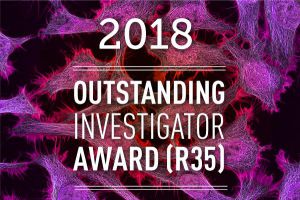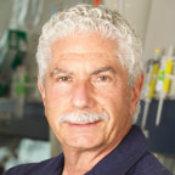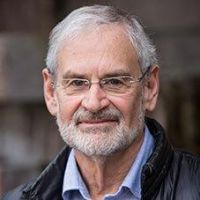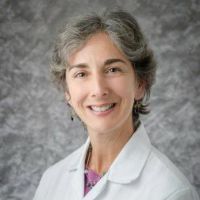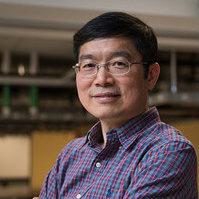Difference between revisions of "Research/nci-role/spotlight/oia"
Jump to navigation
Jump to search
(Marked this version for translation) |
|||
| (3 intermediate revisions by one other user not shown) | |||
| Line 1: | Line 1: | ||
| − | == NCI Outstanding Investigator Award Recipients == | + | <languages/> |
| + | <translate> | ||
| + | == NCI Outstanding Investigator Award Recipients == <!--T:1--> | ||
| − | [[File:OIA2018-article.jpg| | + | <!--T:2--> |
| + | [[File:OIA2018-article.jpg|300px|right]] | ||
| + | <!--T:3--> | ||
NCI’s Outstanding Investigator Award supports accomplished leaders in cancer research, who are providing significant contributions toward understanding cancer and developing applications that may lead to a breakthrough in biomedical, behavioral, or clinical cancer research. Below are profiles of the most recent NCI Outstanding Investigator Award recipients. | NCI’s Outstanding Investigator Award supports accomplished leaders in cancer research, who are providing significant contributions toward understanding cancer and developing applications that may lead to a breakthrough in biomedical, behavioral, or clinical cancer research. Below are profiles of the most recent NCI Outstanding Investigator Award recipients. | ||
| + | |||
| + | <!--T:4--> | ||
{| | {| | ||
|- | |- | ||
| Line 17: | Line 23: | ||
|} | |} | ||
| + | |||
| + | <!--T:5--> | ||
{| | {| | ||
|- | |- | ||
| Line 28: | Line 36: | ||
|} | |} | ||
| + | |||
| + | <!--T:6--> | ||
{| | {| | ||
|- | |- | ||
| Line 34: | Line 44: | ||
|| | || | ||
| + | <!--T:7--> | ||
:Timothy A. Chan, M.D., Ph.DExit Disclaimer | :Timothy A. Chan, M.D., Ph.DExit Disclaimer | ||
:Title: PaineWebber Chair in Cancer Genetics; Member/Professor, Human Oncology and Pathogenesis Program; Director, Immunogenomics and Precision Oncology Platform; :Vice Chair, Department of Radiation Oncology | :Title: PaineWebber Chair in Cancer Genetics; Member/Professor, Human Oncology and Pathogenesis Program; Director, Immunogenomics and Precision Oncology Platform; :Vice Chair, Department of Radiation Oncology | ||
| Line 40: | Line 51: | ||
|} | |} | ||
| + | |||
| + | <!--T:8--> | ||
{| | {| | ||
|- | |- | ||
| Line 46: | Line 59: | ||
|| | || | ||
| + | <!--T:9--> | ||
:David Cheresh, Ph.D.Exit Disclaimer | :David Cheresh, Ph.D.Exit Disclaimer | ||
:Title: Distinguished Professor and Vice Chair in the Department of Pathology | :Title: Distinguished Professor and Vice Chair in the Department of Pathology | ||
| Line 52: | Line 66: | ||
|} | |} | ||
| + | |||
| + | <!--T:10--> | ||
{| | {| | ||
|- | |- | ||
| Line 58: | Line 74: | ||
|| | || | ||
| + | <!--T:11--> | ||
:Arul M. Chinnaiyan, M.D., Ph.D.Exit Disclaimer | :Arul M. Chinnaiyan, M.D., Ph.D.Exit Disclaimer | ||
:Title: Director of the Michigan Center for Translational Pathology | :Title: Director of the Michigan Center for Translational Pathology | ||
| Line 64: | Line 81: | ||
|} | |} | ||
| + | |||
| + | <!--T:12--> | ||
{| | {| | ||
|- | |- | ||
| Line 75: | Line 94: | ||
|} | |} | ||
| + | |||
| + | <!--T:13--> | ||
{| | {| | ||
|- | |- | ||
| Line 86: | Line 107: | ||
|} | |} | ||
| + | |||
| + | <!--T:14--> | ||
{| | {| | ||
|- | |- | ||
| Line 96: | Line 119: | ||
|} | |} | ||
| + | |||
| + | <!--T:15--> | ||
{| | {| | ||
|- | |- | ||
| Line 102: | Line 127: | ||
|| | || | ||
| − | Jennifer Grandis, M.D.Exit Disclaimer | + | <!--T:16--> |
| − | Title: Professor, Otolaryngology-Head and Neck Surgery | + | :Jennifer Grandis, M.D.Exit Disclaimer |
| − | Institution: University of California, San Francisco | + | :Title: Professor, Otolaryngology-Head and Neck Surgery |
| − | Research: There is an emerging epidemic of head and neck cancer caused by human papillomavirus (HPV) among both smokers and nonsmokers. We want to research the key genetic alterations that mediate HPV+ HNC growth, determine the mechanisms of each target, and its role in HPV+ HNC. The findings will contribute to new treatments for HPV+ HNC. Grandis will focus on alterations that activate phosphatidylinositol 3- kinase (PI3K) signaling including changes in PIK3CA, or PTEN loss, and activation of the EGFR family member HER3. These results may relate to other HPV+ cancers including cervical and anal cancers. | + | :Institution: University of California, San Francisco |
| + | :Research: There is an emerging epidemic of head and neck cancer caused by human papillomavirus (HPV) among both smokers and nonsmokers. We want to research the key genetic alterations that mediate HPV+ HNC growth, determine the mechanisms of each target, and its role in HPV+ HNC. The findings will contribute to new treatments for HPV+ HNC. Grandis will focus on alterations that activate phosphatidylinositol 3- kinase (PI3K) signaling including changes in PIK3CA, or PTEN loss, and activation of the EGFR family member HER3. These results may relate to other HPV+ cancers including cervical and anal cancers. | ||
|} | |} | ||
| + | |||
| + | <!--T:17--> | ||
{| | {| | ||
|- | |- | ||
| Line 113: | Line 141: | ||
[[File:Green, Douglas.jpg|200px|left]] | [[File:Green, Douglas.jpg|200px|left]] | ||
|| | || | ||
| − | Douglas R. Green, Ph.D.Exit Disclaimer | + | :Douglas R. Green, Ph.D.Exit Disclaimer |
| − | Title: Peter C. Doherty Endowed Chair of Immunology | + | :Title: Peter C. Doherty Endowed Chair of Immunology |
| − | Institution: St. Jude Children's Research Hospital | + | :Institution: St. Jude Children's Research Hospital |
| − | Research: Green’s research explores the processes of regulated cell death in the forms of apoptosis and necroptosis and seeks to understand how they are tied to other cellular physiologies. His team’s goals are to find what the mechanisms of cell survival in apoptosis/necroptosis are, how these integrate with cell life, and how diverse processes of cellular life integrate with the core mechanisms of apoptosis and necroptosis. Green will continue his studies into the activation and regulation of necroptosis in relation to cellular physiology and develop tools to probe its activation in relation to cancer and other pathologies. | + | :Research: Green’s research explores the processes of regulated cell death in the forms of apoptosis and necroptosis and seeks to understand how they are tied to other cellular physiologies. His team’s goals are to find what the mechanisms of cell survival in apoptosis/necroptosis are, how these integrate with cell life, and how diverse processes of cellular life integrate with the core mechanisms of apoptosis and necroptosis. Green will continue his studies into the activation and regulation of necroptosis in relation to cellular physiology and develop tools to probe its activation in relation to cancer and other pathologies. |
|} | |} | ||
| + | |||
| + | <!--T:18--> | ||
{| | {| | ||
|- | |- | ||
| Line 124: | Line 154: | ||
[[File:Iacobuzio-Donahue, Christine article.jpg|200px|left]] | [[File:Iacobuzio-Donahue, Christine article.jpg|200px|left]] | ||
|| | || | ||
| − | Christine A. Iacobuzio-Donahue, M.D., Ph.D.Exit Disclaimer | + | :Christine A. Iacobuzio-Donahue, M.D., Ph.D.Exit Disclaimer |
| − | Title: Attending and Member | + | :Title: Attending and Member |
| − | Institution: Memorial Sloan Kettering Cancer Center | + | :Institution: Memorial Sloan Kettering Cancer Center |
| − | Research: Pancreatic ductal adenocarcinoma (PDAC) is the most common neoplasm of the pancreas and soon the second most common cancer in the U.S. Iacobuzio-Donahue will research features of intratumoral heterogeneity at the genetic level, what cellular factors influence the evolution of PDA, and if therapies influence PDA evolution. Using whole exome/whole genome sequencing of pancreatic cancer tissues, single cell technologies for copy number alterations and RNA expression, long-term evolution experiments, mouse models and computational models, this research will help with identification of optimal agents and timing of administration based on the evolutionary context of the patients' PDA. | + | :Research: Pancreatic ductal adenocarcinoma (PDAC) is the most common neoplasm of the pancreas and soon the second most common cancer in the U.S. Iacobuzio-Donahue will research features of intratumoral heterogeneity at the genetic level, what cellular factors influence the evolution of PDA, and if therapies influence PDA evolution. Using whole exome/whole genome sequencing of pancreatic cancer tissues, single cell technologies for copy number alterations and RNA expression, long-term evolution experiments, mouse models and computational models, this research will help with identification of optimal agents and timing of administration based on the evolutionary context of the patients' PDA. |
|} | |} | ||
| + | |||
| + | <!--T:19--> | ||
{| | {| | ||
|- | |- | ||
| Line 135: | Line 167: | ||
[[File:Jänne, Pasi article.jpg|200px|left]] | [[File:Jänne, Pasi article.jpg|200px|left]] | ||
|| | || | ||
| − | Pasi A. Jänne, M.D., Ph.D.Exit Disclaimer | + | :Pasi A. Jänne, M.D., Ph.D.Exit Disclaimer |
| − | Title: Director, Lowe Center for Thoracic Oncology; Director, Belfer Center for Applied Cancer Science | + | :Title: Director, Lowe Center for Thoracic Oncology; Director, Belfer Center for Applied Cancer Science |
| − | Institution: Dana-Farber Cancer InstituteExit Disclaimer | + | :Institution: Dana-Farber Cancer InstituteExit Disclaimer |
| − | Research: Genotype directed precision therapies to combat EGFR mutant or ALK rearranged non- small cell lung cancer show favorable response rates and progression free survival compared to chemotherapy. Significant improvements in treatment using precision therapies involve using combination therapies. Jänne will develop combination therapies using dual targeting of EGFR, vertical pathway inhibition and parallel pathway inhibition. He will focus on improving therapies for EGFR inhibitor naïve cancers. The research will inform preclinical approaches to refine treatments and make improvements in the outcome of EGFR mutant and other lung cancer patients. | + | :Research: Genotype directed precision therapies to combat EGFR mutant or ALK rearranged non- small cell lung cancer show favorable response rates and progression free survival compared to chemotherapy. Significant improvements in treatment using precision therapies involve using combination therapies. Jänne will develop combination therapies using dual targeting of EGFR, vertical pathway inhibition and parallel pathway inhibition. He will focus on improving therapies for EGFR inhibitor naïve cancers. The research will inform preclinical approaches to refine treatments and make improvements in the outcome of EGFR mutant and other lung cancer patients. |
|} | |} | ||
| + | |||
| + | <!--T:20--> | ||
{| | {| | ||
|- | |- | ||
| Line 146: | Line 180: | ||
[[File:Kimmelman, Alec article.jpg|200px|left]] | [[File:Kimmelman, Alec article.jpg|200px|left]] | ||
|| | || | ||
| − | Alec Kimmelman, M.D., Ph.D.Exit Disclaimer | + | :Alec Kimmelman, M.D., Ph.D.Exit Disclaimer |
| − | Title: Professor and Chair, Department of Radiation Oncology | + | :Title: Professor and Chair, Department of Radiation Oncology |
| − | Institution: Perlmutter Cancer Center NYU Langone Medical CenterExit Disclaimer | + | :Institution: Perlmutter Cancer Center NYU Langone Medical CenterExit Disclaimer |
| − | Research: Kimmelman’s team has been studying how pancreatic ductal adenocarcinoma (PDAC) rewires the metabolism to proliferate and survive in nutrient poor microenvironments. Integration of PDAC’s metabolic adaptations and how they influence the tumor’s metabolism in vivo is not yet known. Kimmelman will use syngeneic models of pancreatic cancer to assess metabolic dependencies, use co-culture systems to identify metabolic cross-talk in the microenvironment and dissect nutrient scavenging pathways. From this information robust metabolic targets will be tested in vivo. | + | :Research: Kimmelman’s team has been studying how pancreatic ductal adenocarcinoma (PDAC) rewires the metabolism to proliferate and survive in nutrient poor microenvironments. Integration of PDAC’s metabolic adaptations and how they influence the tumor’s metabolism in vivo is not yet known. Kimmelman will use syngeneic models of pancreatic cancer to assess metabolic dependencies, use co-culture systems to identify metabolic cross-talk in the microenvironment and dissect nutrient scavenging pathways. From this information robust metabolic targets will be tested in vivo. |
|} | |} | ||
| + | |||
| + | <!--T:21--> | ||
{| | {| | ||
|- | |- | ||
| Line 157: | Line 193: | ||
[[File:Lyden, David article.jpg|200px|left]] | [[File:Lyden, David article.jpg|200px|left]] | ||
|| | || | ||
| − | David Lyden, M.D., Ph.D.Exit Disclaimer | + | :David Lyden, M.D., Ph.D.Exit Disclaimer |
| − | Title: Professor of Pediatrics | + | :Title: Professor of Pediatrics |
| − | Institution: Weill Medical College of Cornell University | + | :Institution: Weill Medical College of Cornell University |
| − | Research: Dr. Lyden will explore the possibility that inhibition of specific exosomal cargo or their targets in hematopoietic cells could reverse immunosuppression, pre-metastatic niche formation and the systemic effects of cancer. He will study the mechanisms through which exosome subpopulations and exomeres (the most prominent tumor-secreted particles) regulate immune system mobilization, metabolic changes and plasticity of pre-metastatic and metastatic niches in cancer models and patients. | + | :Research: Dr. Lyden will explore the possibility that inhibition of specific exosomal cargo or their targets in hematopoietic cells could reverse immunosuppression, pre-metastatic niche formation and the systemic effects of cancer. He will study the mechanisms through which exosome subpopulations and exomeres (the most prominent tumor-secreted particles) regulate immune system mobilization, metabolic changes and plasticity of pre-metastatic and metastatic niches in cancer models and patients. |
|} | |} | ||
| + | |||
| + | <!--T:22--> | ||
{| | {| | ||
|- | |- | ||
| Line 169: | Line 207: | ||
|| | || | ||
| − | Ari M. Melnick, M.D. Exit Disclaimer | + | <!--T:23--> |
| − | Title: Gebroe Professor of Hematology and Oncology; Chair, Hematologic Malignancies Program | + | :Ari M. Melnick, M.D. Exit Disclaimer |
| − | Institution: Weill Medical College of Cornell University | + | :Title: Gebroe Professor of Hematology and Oncology; Chair, Hematologic Malignancies Program |
| − | Research: Melnick will elucidate how B-cell lymphomas arise through disruption of an intricate network of epigenetic mechanisms that regulate and control the humoral immune response. He proposes that malignant transformation occurs in a different way in the germinal center (GC) B-cells that give rise to follicular lymphoma and diffuse large B-cell lymphomas. For this study, Melnick has assembled technologies such as GC organoids that allow observation of immune synapse signaling, genetically engineered mouse models, and extensive libraries of epigenomic profiles in primary human and murine lymphomas. This information will be leveraged to design clinical trials of novel epigenetic targeted therapies. | + | :Institution: Weill Medical College of Cornell University |
| + | :Research: Melnick will elucidate how B-cell lymphomas arise through disruption of an intricate network of epigenetic mechanisms that regulate and control the humoral immune response. He proposes that malignant transformation occurs in a different way in the germinal center (GC) B-cells that give rise to follicular lymphoma and diffuse large B-cell lymphomas. For this study, Melnick has assembled technologies such as GC organoids that allow observation of immune synapse signaling, genetically engineered mouse models, and extensive libraries of epigenomic profiles in primary human and murine lymphomas. This information will be leveraged to design clinical trials of novel epigenetic targeted therapies. | ||
|} | |} | ||
| + | |||
| + | <!--T:24--> | ||
{| | {| | ||
|- | |- | ||
| Line 180: | Line 221: | ||
[[File:Prives, Carol article.jpg|200px|left]] | [[File:Prives, Carol article.jpg|200px|left]] | ||
|| | || | ||
| − | Carol Prives, Ph.D.Exit Disclaimer | + | :Carol Prives, Ph.D.Exit Disclaimer |
| − | Title: Da Costa Professor of Biological Sciences | + | :Title: Da Costa Professor of Biological Sciences |
| − | Institution: Columbia University | + | :Institution: Columbia University |
| − | Research: There are few effective treatments that prevent oncogenic activities of mutant p53 protein, a major suppressor of cancer. Prives’ research will focus on a novel mechanism by which Mdm2 degrades p53, a series of CRISPR-derived cell lines harboring Li-Fraumeni-Syndrome p53 mutations, p53- independent roles of Mdm2 and MdmX, long non-coding RNAs that are p53 targets, new approaches to understand how p53 identifies its sites in vitro and in vivo and examination at single molecule resolution the localization of wild-type and mutant forms of p53 and Mdm2 after different stimuli. This will help diagnosis and treatment of sporadic and inherited cancers. | + | :Research: There are few effective treatments that prevent oncogenic activities of mutant p53 protein, a major suppressor of cancer. Prives’ research will focus on a novel mechanism by which Mdm2 degrades p53, a series of CRISPR-derived cell lines harboring Li-Fraumeni-Syndrome p53 mutations, p53- independent roles of Mdm2 and MdmX, long non-coding RNAs that are p53 targets, new approaches to understand how p53 identifies its sites in vitro and in vivo and examination at single molecule resolution the localization of wild-type and mutant forms of p53 and Mdm2 after different stimuli. This will help diagnosis and treatment of sporadic and inherited cancers. |
|} | |} | ||
| + | |||
| + | <!--T:25--> | ||
{| | {| | ||
|- | |- | ||
| Line 192: | Line 235: | ||
|| | || | ||
| − | John Quackenbush, Ph.D.Exit Disclaimer | + | <!--T:26--> |
| − | Title: Chair, Department of Biostatistics | + | :John Quackenbush, Ph.D.Exit Disclaimer |
| − | Institution: Harvard T.H. Chan School of Public Health | + | :Title: Chair, Department of Biostatistics |
| − | Research: Biological systems operate through the action of complex networks of genes, proteins, and other molecules working together. But deducing these networks from “snapshots” of a cell’s mutations, or gene expression, or any set of single measurements is like trying to learn the rules of football armed only with still photographs of a game. We have developed methods that use our existing understanding of biology to guess a cell’s networks, and then to use data to refine those models to better fit the data. Quackenbush’s team will develop systems-based modeling in cancer with the goal of understanding how the disease develops, to explore potential treatment options, and to study sex differences in cancer risk and response to therapy. | + | :Institution: Harvard T.H. Chan School of Public Health |
| + | :Research: Biological systems operate through the action of complex networks of genes, proteins, and other molecules working together. But deducing these networks from “snapshots” of a cell’s mutations, or gene expression, or any set of single measurements is like trying to learn the rules of football armed only with still photographs of a game. We have developed methods that use our existing understanding of biology to guess a cell’s networks, and then to use data to refine those models to better fit the data. Quackenbush’s team will develop systems-based modeling in cancer with the goal of understanding how the disease develops, to explore potential treatment options, and to study sex differences in cancer risk and response to therapy. | ||
|} | |} | ||
| + | |||
| + | <!--T:27--> | ||
{| | {| | ||
|- | |- | ||
| Line 203: | Line 249: | ||
[[File:Tainer, John article.jpg|200px|left]] | [[File:Tainer, John article.jpg|200px|left]] | ||
|| | || | ||
| − | John A. Tainer, Ph.D.Exit Disclaimer | + | :John A. Tainer, Ph.D.Exit Disclaimer |
| − | Title: Professor in the Department of Molecular and Cellular Oncology | + | :Title: Professor in the Department of Molecular and Cellular Oncology |
| − | Institution: The University of Texas MD Anderson Cancer Center | + | :Institution: The University of Texas MD Anderson Cancer Center |
| − | Research: Cancer is linked to almost every human DNA repair (DR) pathway. Yet, the effects of DNA damage depend on poorly understood DR complexes that are targets for treatments. Tainer seeks to define and test DR changes that will inform BRCA protein essentiality in cells and synthetic lethality in tumors, as well as strategies to control the abscopal effect (where ionizing radiation is immunosuppressive yet can activate an immune response to kill tumors distant from the radiation site). Results will produce data to combine measurements from molecules to cells, help design dissection-of-function mutations and inhibitor tools, and predict biological outcomes. | + | :Research: Cancer is linked to almost every human DNA repair (DR) pathway. Yet, the effects of DNA damage depend on poorly understood DR complexes that are targets for treatments. Tainer seeks to define and test DR changes that will inform BRCA protein essentiality in cells and synthetic lethality in tumors, as well as strategies to control the abscopal effect (where ionizing radiation is immunosuppressive yet can activate an immune response to kill tumors distant from the radiation site). Results will produce data to combine measurements from molecules to cells, help design dissection-of-function mutations and inhibitor tools, and predict biological outcomes. |
|} | |} | ||
| + | |||
| + | <!--T:28--> | ||
{| | {| | ||
|- | |- | ||
| Line 215: | Line 263: | ||
|| | || | ||
| − | Cheryl Lyn Walker, Ph.D.Exit Disclaimer | + | <!--T:29--> |
| − | Title: Director of the Center for Precision Environmental Health; Alkek Presidential Chair in Environmental Health; Professor, Departments of Molecular and Cellular Biology, Medicine and Genetics | + | :Cheryl Lyn Walker, Ph.D.Exit Disclaimer |
| − | Institution: Baylor College of Medicine | + | :Title: Director of the Center for Precision Environmental Health; Alkek Presidential Chair in Environmental Health; Professor, Departments of Molecular and :Cellular Biology, Medicine and Genetics |
| − | Research: The cell’s methylation machinery serves two coding functions, one on chromatin and one on the cytoskeleton. Walker’s team seeks to understand how cells utilize and regulate one machinery with two distinct, but equally important, remodeling functions on chromatin and the cytoskeleton. As a result, defects in chromatin remodeler genes can directly impact the cytoskeleton, which in cancer, can drive genomic instability and cause cytoskeletal defects that alter mobility to promote metastasis. This research will help inform understanding the role of chromatin remodelers in cancer, and the development of therapies with efficacy against both the chromatin and cytoskeletal alterations caused by defects in genes encoding dual-function chromatin-cytoskeleton remodelers. | + | :Institution: Baylor College of Medicine |
| + | :Research: The cell’s methylation machinery serves two coding functions, one on chromatin and one on the cytoskeleton. Walker’s team seeks to understand how cells utilize and regulate one machinery with two distinct, but equally important, remodeling functions on chromatin and the cytoskeleton. As a result, defects in chromatin remodeler genes can directly impact the cytoskeleton, which in cancer, can drive genomic instability and cause cytoskeletal defects that alter mobility to promote metastasis. This research will help inform understanding the role of chromatin remodelers in cancer, and the development of therapies with efficacy against both the chromatin and cytoskeletal alterations caused by defects in genes encoding dual-function chromatin-cytoskeleton remodelers. | ||
|} | |} | ||
| + | |||
| + | <!--T:30--> | ||
{| | {| | ||
|- | |- | ||
| Line 227: | Line 278: | ||
|| | || | ||
| − | Lihong Wang, Ph.D.Exit Disclaimer | + | <!--T:31--> |
| − | Title: Bren Professor of Medical Engineering and Electrical Engineering | + | :Lihong Wang, Ph.D.Exit Disclaimer |
| − | Institution: California Institute of Technology | + | :Title: Bren Professor of Medical Engineering and Electrical Engineering |
| − | Research: There remains an imperative need for more advanced breast imaging technologies. Wang will work to develop two innovative high-speed 3D photoacoustic computed tomography (PACT) systems to diagnose breast lesions. One is a single-breath-hold 3D breast imaging system with nearly isotropic 3D resolutions and dual-wavelength contrasts, and the second is a snapshot 3D breast PACT system. Wang’s team will test the PACT for the diagnosis of lesions by comparing with the gold standard of tissue pathology — leading to a more streamlined and accurate workup that reduces unnecessary follow-up imaging and benign breast biopsies. | + | :Institution: California Institute of Technology |
| + | :Research: There remains an imperative need for more advanced breast imaging technologies. Wang will work to develop two innovative high-speed 3D photoacoustic computed tomography (PACT) systems to diagnose breast lesions. One is a single-breath-hold 3D breast imaging system with nearly isotropic 3D resolutions and dual-wavelength contrasts, and the second is a snapshot 3D breast PACT system. Wang’s team will test the PACT for the diagnosis of lesions by comparing with the gold standard of tissue pathology — leading to a more streamlined and accurate workup that reduces unnecessary follow-up imaging and benign breast biopsies. | ||
|} | |} | ||
| + | </translate> | ||
Latest revision as of 21:56, 29 October 2019
NCI Outstanding Investigator Award Recipients
NCI’s Outstanding Investigator Award supports accomplished leaders in cancer research, who are providing significant contributions toward understanding cancer and developing applications that may lead to a breakthrough in biomedical, behavioral, or clinical cancer research. Below are profiles of the most recent NCI Outstanding Investigator Award recipients.
|
|
|
|
|
|
|
|
|
|
|
|
|
|
|
|
|
|
|
|
